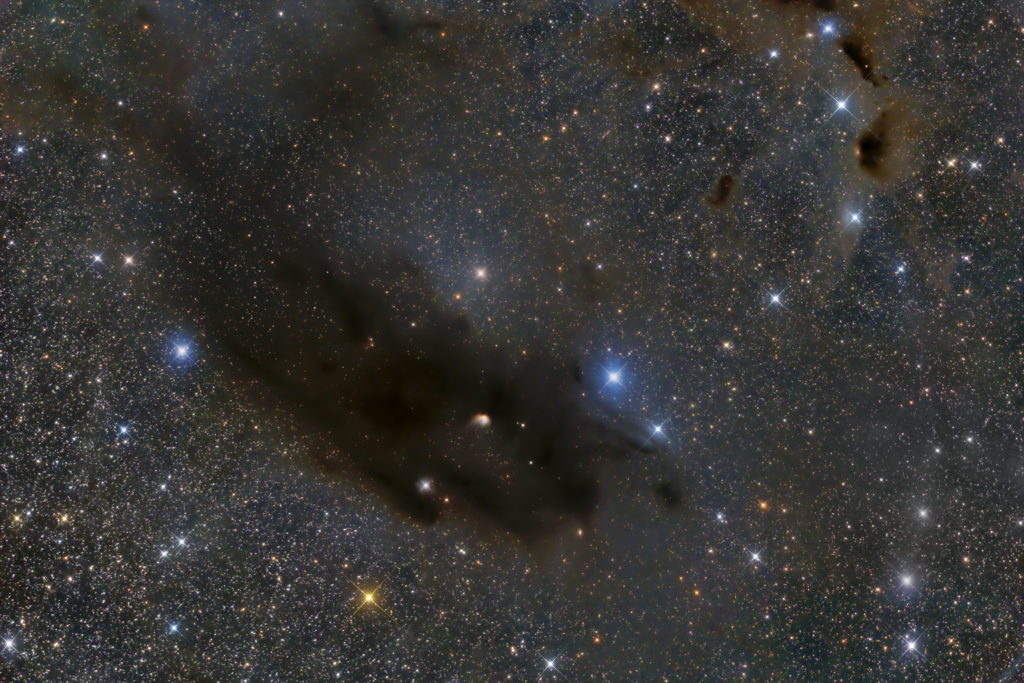
Not far from the Pleiades and Hyades star clusters along the northern Milky Way lies the coal-black fingers of the Taurus Molecular Cloud, the nearest star-forming region to Earth. Unlike the more famous Orion star factory, with the dazzling Orion Nebula and associated bright blue-white stars, the TMC is not well known to most stargazers. That’s because it doesn’t offer much to see, with no bright nebulae and just a dark and sooty network of tendrils that span more than 30o of sky. But the TMC is the nearest star-forming region to Earth, making it of considerable interest to astronomers. It’s also a rewarding target for astrophotographers who can capture its structure against the starry background in the constellations Taurus and Auriga.
The TMC contains hundreds of solar masses of primordial hydrogen and helium gas as well as heavier elements cast off by long dead stars. There’s also much stardust here. Not the sparkly kind that poets and artists ponder, but condensed and icy grains of hydrocarbons more akin to diesel exhaust than diamond dust. This dark stardust, the components of which are cast off from the pulsating cores of sunlike stars and freeze like microscopic snowflakes in interstellar space, helps obscure the visible light from the background stars and gives the TMC is dusky appearance.
But there’s plenty going on inside these dark clouds. It’s here the galaxy gets down to the business of making new stars from the cast-off material of the old. In visible light, this star forming process remains out of sight. But space-based telescopes equipped with infrared detectors and cameras see a great deal of star forming activity in TMC-1. The Herschel Space Telescope, in particular, which detects far infrared light and heat can directly see filaments of gently glowing dust where new star formation is underway. The newest stars in the TMC are just 1-2 million years old, and hundreds of new stars are in the process of forming.

Astronomers once thought the TMC, along with other nearby star-forming regions along the Milky Way, lay within the Gould Belt, a 3,000 light-year-long arc of bright stars roughly centered on our solar system. But the idea of the Gould Belt was superseded in 2020 by the discovery by Harvard astronomers of a much larger structure. Called the Radcliffe Wave, this 8,800 light-year-long undulating assembly comprises a substantial portion of the Local Arm of the Milky Way. It includes star forming regions in Orion, Perseus, Cepheus, and Cygnus.
The Taurus Molecular Cloud is extremely difficult to see visually. A pair of good binoculars and a black night sky are required to even try. The most concentrated fingers of darkness lie in the patch of sky about 10o west of a line between the Pleiades and Hyades.
But it’s a much easier structure to capture photographically in very dark sky. The thickest obscuring fingers of the structure lie in front of a rich stellar tapestry adjacent to the Perseus Arm of the Milky Way. The image at the top of this article, for example, was captured with a modern digital camera (Nikon Z6) and fast lens (Nikon 35mm S at f/1.8). Many astrophotographers image smaller segments of the TMC through longer focal length telescopes to capture the fine detail in these complex molecular clouds (see image above). A few intrepid astrophotographers have followed in the footsteps of the great E. E. Barnard, the patron saint of astrophotographers who first imaged this structure, and painstakingly captured the TMC on modern film stock.

Barnard himself was an avid student of the dark molecular clouds along the Milky Way. In the late 19th and early 20th centuries, this self-taught astronomer distinguished himself as perhaps the keenest visual observer since William Herschel more than 200 years earlier. But Barnard was also steeped in the early technology of photography, having first worked as a small boy after the Civil War turning a large mirror to follow the sun each day to supply light to a Nashville photographic studio. His expertise in optics and photographic emulsions led to a long-standing effort to photograph segments of the Milky Way and catalog more than three hundred of these dark nebulae.
Barnard was convinced these nebulae were long tunnels in the Milky Way with few stars. Others believed, accurately, they were dark obscuring material that lay between us and the background stars. It was Barnard’s image of the TMC, which he called “one of the most important” of his collection, that convinced him of the existence of this obscuring material. It took a few more decades after Barnard’s death in 1923 for astronomers to deduce the true composition of these dark nebulae.
Observing and understanding these dark but wondrous objects gives us a glimpse into our own past and future. Our sun formed in a dark nebula like the Taurus Molecular Cloud some five billion years ago. And in another five billion years, give or take, a good portion of the sun and the scorched inner planets, including Earth, will be returned to interstellar space to seed future clouds from which new solar systems will form.
Share This: